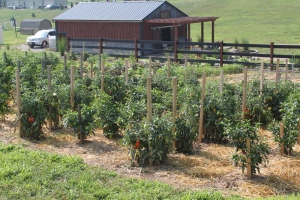Producing vegetable can take it’s toll on your garden soil – you need to replenish the nutrients each year.
There are no two ways about it. Your garden soil is tired and hungry! It has been using it’s nutrients to feed your fruits and vegetables through the spring and summer – all the while being pounded by rain, wind and the baking hot sun.
It needs fed and put to bed this fall so that it’s ready to come to life again next spring!
When we talk about feeding your garden – we’re talking about giving natural, organic and long-lasting nutrition to your soil – not loading it up with synthetic fertilizers that do little to help the structure of your soil.
Healthy soil keeps your garden productive year after year.
Commercial fertilizers are comparable to fast food for your body. They may taste good at first and provide a short term fix to your hunger – but in the long run – they can wreak havoc on your health, or in this case, your soil.
So this fall – here are 3 great ways to rejuvenate your soil naturally and inexpensively. Any one by themselves will add vitality and organic matter to your spent soil. But at the end of the article, you can see how we use all 3 at once to keep our beds teeming with nutrients year after year.
COMPOST
This is great time to dig in compost made through the summer months.
Compost is to the soil what a healthy balanced diet is to the body. It replenishes and feeds soil by adding all types of life-giving organic material, microbes and nutrients.
We make a lot of compost throughout the summer. Each fall, we work about an inch or two of the “black gold” into the top of the soil on each planting row.
If you don’t make your own compost – fall is a great time to start your first pile with the availability of so many easy to find materials. (See – Making Compost 101)
COVER CROPS
We use annual rye as a cover crop to add back nutrients and keep the soil protected through the winter
Fall cover crops play a vital role in developing and enriching the soil in your garden. They minimize soil erosion over the winter, and hinder the establishment of weeds. To top it all off – they then feed your soil with organic matter when turned over in the early spring. Of all three of the methods in this article – this is by far the most important in the long-term life and vitality of your garden. (See – Planting Cover Crops)
Here in Ohio – cover crops can be planted anytime from late September to the end of October – the seed just needs enough time to come up with a few inches of growth before winter sets in.
What is best to plant?
We prefer annual rye – it sprouts fast, grows fast and thick – and has deep roots that loosen the soil. Other good crops to choose from are buckwheat, clover, and hairy vetch.
LEAVES
Leaves are one of the most inexpensive ways to add nutrients back to your garden soil each fall.
Leaves are the most inexpensive way to provide your garden with organic matter each fall.
We take leaves and shred them up with our lawnmower – and then spread a 2” layer on top of each raised planting row. You can either dig it into your soil with a pitchfork – or let it decompose on top and turn it under next spring before planting. This latter method also helps to provide your soil with protection from the winter winds and erosion.
If you are not blessed with trees on your property – take a drive around and find neighborhoods that are – it usually won’t long to find them. Many times, the hard work is done for you – with the homeowners already raking leaves to their curb or even bagging them up curbside for pickup. A simple asking of the homeowner can usually net you more than you can handle.
Although leaves are plentiful this time of year – some are better than others. Maple, Birch, Ash, Beech and fruit tree leaves are fantastic to compost.(See – Tips To Composting Leaves)
Oak leaves on the other hand should be composted in moderation. The leaves of Oak trees tend to be more acidic – too many in the compost pile can result in compost that is less than ideal for most vegetable gardens.
THE FALL GARDEN REJUVENATING TRIFECTA
Cover crops, compost and shredded leaves have kept our garden producing well year after year.
So if you really want to rejuvenate the soil – do all three at once – it’s what we like to call the Fall Garden Trifecta – and it has worked wonders to keep our garden producing heavy yields, year after year.
When your garden has run its course this year – clean it out and gently rake your soil. Add a few inches of compost to your growing space and rake it into the soil.
Next, plant your cover crop in the loose soil and gently rake it in.
Finally – put on about an inch of shredded leaves on top of the seed. The leaves will help to hold the moisture in and germinate the seed – and keep weed seeds from blowing in until the cover crop is established. As your cover crops sprouts – it will grow through the leaves and hold it to the soil.
Next spring – you can turn it all under before you plant – and your garden will thank you!
If you would like to receive our DIY & Gardening Tips every Tuesday – be sure to sign up to follow the blog via email in the right hand column, “like” us on Facebook, or follow us on Twitter.
Happy Gardening – Jim and Mary!






Recent Comments